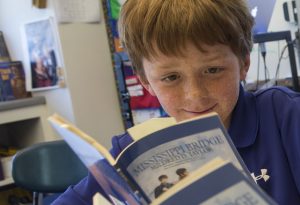In a world where technology is ubiquitous, games and entertainment are available at our fingertips, and attention spans are shrinking, is there a sweeter sight than your child engrossed in the pages of an actual book?
Fourth grade is one of the most critical years for your developing reader, and this year can make a significant impact on your child’s academic future. During this time, students become more sophisticated readers; they’re learning to analyze text, to distinguish fiction from nonfiction, and to dive beneath the surface to identify deeper meanings and messages.
So, what can you do to foster a love of reading in your child and improve his or her literacy skills? There are many things you can do at home, such as regularly read to your child and pause to ask and answer questions. But it is essential to ensure that your child’s school is supporting your efforts and setting the stage for future success. Here are three things to consider for your young reader:
Give Them the Power of Choice
According to a 2000 study by John T. Guthrie and Allan Wingfield, “providing genuine student choices increases effort and commitment to reading.” Their research posits that if children get to choose what they’re reading, they are more likely to be invested in the material and develop positive reading habits and skills.
 Fourth grade teachers at The Fessenden School are adamant about incorporating choice into their reading program. In fact, they recently redesigned their curriculum to increase opportunities for students to make their own book selections throughout the school year. Two of the most notable outcomes of the new curriculum are the number of books boys are reading and the enthusiasm with which they’re approaching their materials.
Fourth grade teachers at The Fessenden School are adamant about incorporating choice into their reading program. In fact, they recently redesigned their curriculum to increase opportunities for students to make their own book selections throughout the school year. Two of the most notable outcomes of the new curriculum are the number of books boys are reading and the enthusiasm with which they’re approaching their materials.
Fourth Grade Teacher Marjorie Hendrick states that her students race into her classroom in the morning and demand, “Can we read our books?” They regularly cheer when reading time is announced. She frequently sees boys engrossed in books, dog-earring the pages or using Post-its to mark something noteworthy.
Find a Proven School Curriculum Based on Individual Assessments
Since the Common Core State Standards were launched in 2009, U.S. fourth graders’ reading scores have declined. According to a 2016 study, “Reading Achievement of U.S. Fourth-Grade Students in an International Context,” both the national average test scores and international rankings have declined.
In response to this growing trend, Fessenden utilizes Teachers College Reading and Writing Project (TCRWP) as the foundation for its reading curriculum. The mission of TCRWP is to “help young people become avid and skilled readers, writers, and inquirers.” The approach utilizes data-based and standards-based instruction and fosters a learning progression from Pre-K through Grade 5 to accelerate progress in reading and literacy.
 Marjorie states, “Students are not all reading the same book, and they’re not reading them in the same way, because that’s not who we are as readers.” She adds that the goal of their curriculum is to emulate real-life reading. Marjorie shares that teaching at an all-boys school requires a delicate balance of freedom and structure. “You have to walk the tightrope of giving boys movement and freedom of choice while also providing significant structure and planning. We’re really specific in the skills that we’re teaching.”
Marjorie states, “Students are not all reading the same book, and they’re not reading them in the same way, because that’s not who we are as readers.” She adds that the goal of their curriculum is to emulate real-life reading. Marjorie shares that teaching at an all-boys school requires a delicate balance of freedom and structure. “You have to walk the tightrope of giving boys movement and freedom of choice while also providing significant structure and planning. We’re really specific in the skills that we’re teaching.”
These skills include accuracy, comprehension, and fluency. In other words, are students reading words correctly? Are they understanding what they’re reading? And are they reading at a good rate and using expression and punctuation to help them understand the material?
Ensure that Reading and Writing Go Hand-in-Hand
Research indicates that writing is a powerful tool for improving the way students read, think, and learn. According to a 2010 study by Steve Graham and Michael Hebert titled “Writing to Read,” one way to enhance reading comprehension is to encourage children to write about what they read. And so, Fessenden fourth graders are encouraged to keep “Reader’s Notebooks,” which can include sticky notes, story maps, or “Stop-and-Jots” to help them better understand the text and who they are as readers.
What are some things you do at home to enhance your child’s love of reading? And what do you look for in a school’s literacy curriculum? Tell us in the comments section below.





As the wise saying goes….
“There is more treasure in books than in all the pirate’s loot on Treasure Island.” – Walt Disney
Took me time to read all the comments, but I genuinely enjoyed the article. It proved to become extremely beneficial to me and I am positive to all of the commenters here! It is constantly nice whenever you can not only be informed, but additionally entertained! Im sure you had enjoyment writing this post. Have you considered promoting your blog? add it to SEO Directory right now 🙂